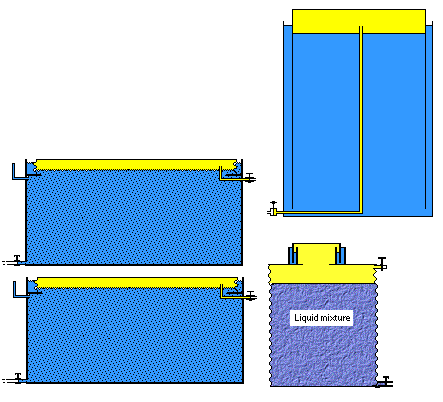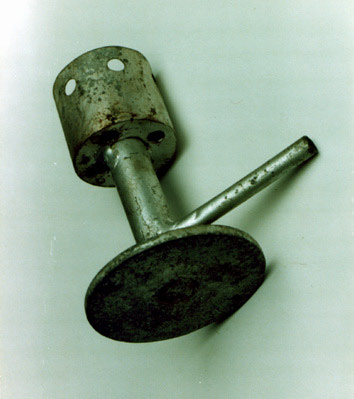|
|
|||||
|
|
|
|
|
|
Mombasa Project |
|
|
|
|
|
Flexible Biogas device in Kenya | Biogas in Kenya |
|
|
|
From 1972 to 1974 I was teaching at a school in Kakamega District in Western Kenya. This school had some agricultural activities including pigs, chickens, cows and various crops including Kikuyu grass. I lived in a government supplied bungalow with a small garden suitable for vegetables and bananas. The school had its own water supply from a borehole and was connected to the electric grid. Ever since I first came out to Africa in 1965, I had been interested in forms of energy not reliant on imported oil and gas. My first project had been to organise a science competition at Kakamega High School where I offered a prize for students who constructed a device that would boil water using solar energy alone. I left information about how to do it in the Library but did not draw their attention to it. I was interested in how they set about this project. One entrant did indeed build a working device using a parabolic mirror made from cardboard and aluminium foil. While at Kakamega School from 1966 to 1968 I read about a Kenya farmer who had diversified into biogas and equipped his farm and sold devices for others to do it. He was at the Tunnel Company. It was only when I returned to Kenya in 1972 after two years in Botswana that I decided to try making biogas myself. Unlike my Nigeria project I didn't actually need the gas as my house had a regular supply of electricity. I started by getting a tank maker in Kisumu to make me a digestion tank to my design. He also made for me a small gas holder. The digestion tank was made of corrugated iron rolled into a tube, with a plate at the bottom. I think it was soldered rather than welded. At the top there was another plate with a circular hole in it to allow material to be put into it. Into this fitted a lid (but this was a fundamental error as it wasn't sealed). Also at the top there was an outlet for the gas controlled by a half inch gate valve. At the bottom there was an outlet controlled by a gate valve - I think it was one inch size. This was to allow liquids to be drawn off after they had produced gas. These liquids were put on to my garden to grow vegetables. Later when I had a vegetation tank the liquids were put into that to provide nitrogen to assist the vegetation process and to supply the bacteria to start it off. This original digestion tank was intended to use only animal wastes. The school had some pigs and cows and chickens so I used the produce of these animals. I collected some of the dung from these animals and put it in the digestion tank. I can't now remember whether I looked for the active bacteria to make the process work. Nearly always one can start a new digestion tank by putting into it some material from an already operating tank, but I didn't know anyone who who had one at that time.  I was still learning how to build gas plants and I had failed to find a means of sealing the gas into the tank. I needed to have a floating lid so I ordered one from the tank maker and soldered it to the top of the tank. This was the gas proof lid. It had a water seal. The pressure of the gas pushed down the level of the water inside. Any rain that fell would not get into the tank. To refill the digester I turned off the gate valve at the gas outlet. Then I would let out some of the mixture from the bottom valve into a bucket (for the garden). Then I lifted the lid and put a liquid mixture of animal manure into the hole. I then replaced the lid. There was a small danger that some oxygen would get into the gas pipe. To prevent an explosion I would turn off the gate valve at the gasholder and allow all the gas in the pipe to escape for a few minutes. Thus no explosive mixture would build up in the pipe. My Nigeria system cured this problem by never lifting the lid off the tank and never exposing the mixture to the air. |
 |
 |
|
After sealing this new lid I found the mixture in the tank was bubbling vigorously and I had enough gas to raise the small gas holder. I soon found that the gas holder I had ordered was far too small. It wasn't big enough to store more gas than would be used in a few minutes of cooking. I had also ordered from the Tunnel Company a cooker designed for use with biogas and a burner suitable to put in a kerosene powered refrigerator. At this point I had a system but it wasn't much use. At about this time I visited the Tunnel Company at Fort Ternan near Kisumu. There I saw the designs for vegetable digesters and I ordered one. When it arrived I also ordered from the tank maker in Kisumu a much larger gas holder. This was big enough to store all the gas produced in a day. |
 |
|||

|

|
||
| These drawings are based on a design produced by the Tunnel Company in Kenya. The lid was held in place - because the gas tends to push it up - by bars placed across it. |
|
|
 |
|
|
 |
|
I had two of the digesters described above. Because Musingu is quite high up the temperature goes down at night so that the overall temperature is below the ideal (37oC) for biogas digestion. I did try to cover the tanks with plastic sheeting but the sheeting was stolen. I kept the tanks producing for about 6 weeks, although it might well have been cool enough to need 8 weeks before all the carbon had been processed. With two tanks operating for 6 weeks I had to empty and refill the tanks on a three weeks cycle. That is, there was always at least one tank producing gas. As it reached the end of its cycle with the daily output of gas falling, the other tank would be in the first half of its cycle with the rate of production rising. When I planned to move the whole system to Rusinga Island I intended to add another tank to make three. At that height above sea level the overall temperature is much higher and I would have allowed a 4 week digestion time. (This plan never happened). Materials
|




